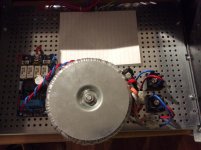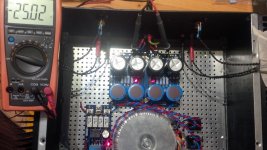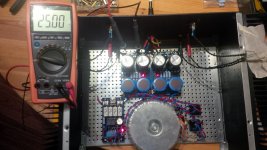When you say solders not allowed, does that include,
for instance,
where you have those 2 cl60s next to each other, i would twist the leads together to stop them falling apart before inserting into the connector block, can i not use solder to hold them together and make sure they don't get separated/mangled by the connector block screw?
I thought a lot of guitar amps use point to point wiring, including high tension supplies. Im sure my Groove tubes power amp has high tension wires soldered to the caps on the power supply.
I often tin my mains cables as well to stop them fraying either before they go into a screw terminal or a crimp. I seem to be able to get a more solid fix on it.
I would have thought if these parts were getting hot enough to soften the solder they would be melting insulation and all sorts.
Can you recommend a book with all these sorts of rules in?
for instance,
where you have those 2 cl60s next to each other, i would twist the leads together to stop them falling apart before inserting into the connector block, can i not use solder to hold them together and make sure they don't get separated/mangled by the connector block screw?
I thought a lot of guitar amps use point to point wiring, including high tension supplies. Im sure my Groove tubes power amp has high tension wires soldered to the caps on the power supply.
I often tin my mains cables as well to stop them fraying either before they go into a screw terminal or a crimp. I seem to be able to get a more solid fix on it.
I would have thought if these parts were getting hot enough to soften the solder they would be melting insulation and all sorts.
Can you recommend a book with all these sorts of rules in?
When you say solders not allowed,
That is very clear..................
You need to connect the PE wire direct and permanently to chassis. Soldering is not allowed: A permanent mechanical fixing...................
Do not solder the PE wire. Use a mechanical permanent fixing.
all these other examples are not the PE.does that include,
for instance,
where you have those 2 cl60s next to each other, i would twist the leads together to stop them falling apart before inserting into the connector block, can i not use solder to hold them together and make sure they don't get separated/mangled by the connector block screw?
I thought a lot of guitar amps use point to point wiring, including high tension supplies. Im sure my Groove tubes power amp has high tension wires soldered to the caps on the power supply.
I often tin my mains cables as well to stop them fraying either before they go into a screw terminal or a crimp. I seem to be able to get a more solid fix on it.
I would have thought if these parts were getting hot enough to soften the solder they would be melting insulation and all sorts.
Can you recommend a book with all these sorts of rules in?
You can do what you like as long as it's safe relative to the voltage you're working with.
Last edited:
When you say solders not allowed, does that include,
for instance,
where you have those 2 cl60s next to each other, i would twist the leads together to stop them falling apart before inserting into the connector block, can i not use solder to hold them together and make sure they don't get separated/mangled by the connector block screw?
I thought a lot of guitar amps use point to point wiring, including high tension supplies. Im sure my Groove tubes power amp has high tension wires soldered to the caps on the power supply.
I often tin my mains cables as well to stop them fraying either before they go into a screw terminal or a crimp. I seem to be able to get a more solid fix on it.
I would have thought if these parts were getting hot enough to soften the solder they would be melting insulation and all sorts.
Can you recommend a book with all these sorts of rules in?
Tinning before inserting into screw terminals or crimps is bad practice, because solder is malleable , and has no resilience. That means that any vibrations on the leads will cause the solder to be compressed under the terminal screw, or crimp barrel, and won't hold it's shape. This will cause the termination to loosen after time.
For crimps, soldering after crimping is acceptable, but not necessary in most applications, as a properly formed crimp termination, using correct crimps and tools is both electrically and mechanically sound.
A better method for protecting wires under screw terminals is to use bootlace ferrules, especially for fine wiring.
Just preparing for my Power supply boards to arrive, so I wired my transformer up and my bridge rectifiers and got a few readings I didn't expect? It's a 18v 18v 400va transformer , which shows about 19v on the secondaries but readings after the bridges are about 17.6dc..?? Is this normal? I thought the dc out was higher than the ac in?!
Thanks.....
Thanks.....
And these are the bridges....
http://www.mouser.co.uk/search/ProductDetail.aspx?r=512-GBPC3510#
http://www.mouser.co.uk/search/ProductDetail.aspx?r=512-GBPC3510#
you have done the first part of your checking. Getting the transformer to power on without the bulb lighting up is good.Just preparing for my Power supply boards to arrive, so I wired my transformer up and my bridge rectifiers and got a few readings I didn't expect? It's a 18v 18v 400va transformer , which shows about 19v on the secondaries but readings after the bridges are about 17.6dc..?? Is this normal? I thought the dc out was higher than the ac in?!
Thanks.....
Now add on the smoothing capacotor/s and see if the bulb still does not light up.
arjanv -
Buy 2 of these.
GBPC3502T GeneSiC Semiconductor | Discrete Semiconductor Products | DigiKey
Simpler, easier to use, smaller, works better, and MUCH less money than 8 diodes, 8 heatsinks. I greatly prefer these bridge blocks to discrete.
Buy 2 of these.
GBPC3502T GeneSiC Semiconductor | Discrete Semiconductor Products | DigiKey
Simpler, easier to use, smaller, works better, and MUCH less money than 8 diodes, 8 heatsinks. I greatly prefer these bridge blocks to discrete.
arjanv -
Buy 2 of these.
GBPC3502T GeneSiC Semiconductor | Discrete Semiconductor Products | DigiKey
Simpler, easier to use, smaller, works better, and MUCH less money than 8 diodes, 8 heatsinks. I greatly prefer these bridge blocks to discrete.
okay. So i can leave out the "Discrete Diode Bridge"? and replace it with 2 rectifiers?
- Home
- Amplifiers
- Power Supplies
- diyAudio Power Supply Circuit Board v3 illustrated build guide



